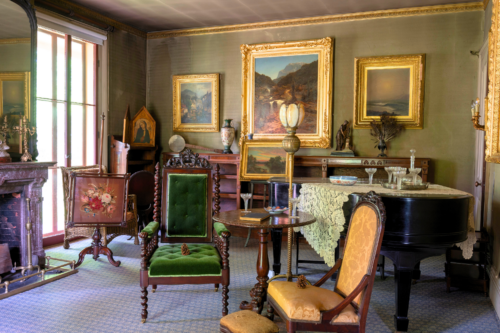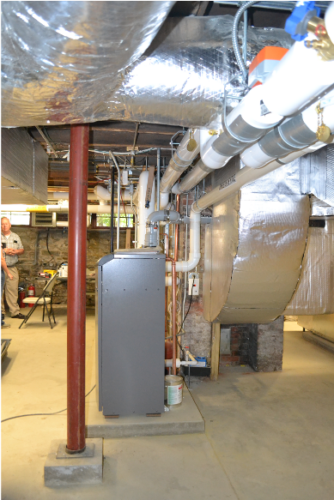INTRODUCTION
 The Emily Dickinson Museum (EDM) received a Sustaining Cultural Heritage Collections grant from the National Endowment for the Humanities to enhance environmental conditions renowned poet and her family. The largest and most varied collection of non-manuscript objects associated historically with the poet and her family had been stored since 1916 in The Evergreens, an Italianate two-story wood-frame house built by the Dickinson family in 1856.
The Emily Dickinson Museum (EDM) received a Sustaining Cultural Heritage Collections grant from the National Endowment for the Humanities to enhance environmental conditions renowned poet and her family. The largest and most varied collection of non-manuscript objects associated historically with the poet and her family had been stored since 1916 in The Evergreens, an Italianate two-story wood-frame house built by the Dickinson family in 1856.
THE PROBLEM
The Evergreens has been heated by a residential-grade forced hot air gas furnace through a distribution system that has changed little since the mid-20 th century. Heat reached heated only five of the eleven first floor rooms and only two of the six rooms on the second floor. There was no form of air conditioning until 2007. Monitoring data confirmed that significant swings in temperature and humidity between different areas of the house and across seasons threatened very limited life expectancies for Dickinson family artifacts including art, family furniture, and personal possessions. The central problem has been the “stack effect” caused by The Evergreens style of architecture. Stack effect results from infiltration of cold outdoor air through crevices in masonry, gaps between window sash/frames and door frames, and openings for building systems, and exfiltration of warmed air through gaps on upper floors. The Evergreens open main hall and the difference in height between perforations in the three-story structure create the stack effect which reaches extremes in the winter. The effect is reversed in summer with exfiltration of cooled dehumidified interior air at perforations in lower stories and infiltration of warm moist air in upper stories and attics.
THE PROJECT

Cellar mechanicals at The Evergreens
The Emily Dickinson Museum established seven objectives for the environmental improvements project, and all have either been accomplished or will be born out through further monitoring and evaluation.
1. Set realistic expectations for building and system performance. A first step was a study of the building’s “comportment” – that is, the limits of an improved environment that the structure’s architectural style, building materials, and location in a New England valley climate will allow. The results of the study helped the Museum establish refined and more reasonable performance standards.
Specification for ASHRAE Classes and Proposed Class Control for the Evergreens table
2. Reduce the loss of conditioned air and the intrusion of water vapor. Non-mechanical improvements to the building envelope included attic insulation and a vapor barrier combined with storm window upgrades, weatherstripping, air-sealing, and segregation of unconditioned spaces to reduce exfiltration/infiltration.
3. Reduce the sensitivity of the internal environment to external conditions. Upgraded insulation and reduction of cold air and moisture infiltration will do a better job of maintaining relatively constant conditions inside the building even though outdoor climate conditions change more quickly.
4. Filter pollutants and inhibit conditions leading to pest infestation and growth of mold and mildew. The system criterion for MERV 13 filtration standard, recommended by previous conservation assessments, has been implemented in this project. Standards for relative humidity are set to inhibit mold/mildew growth, which had been a persistent issue in the uncontrolled Evergreens environment. In past years, some visitors remarked on the house’s dank air quality. Although the general public may not be aware of the specific benchmarks the Museum wishes to achieve, those familiar with the house who have entered since the system has become operational have remarked on the improvement in visitor comfort.
5. Reduce thermal, solar radiation, and ultraviolet loads at windows and French doors. New solar shades have significantly reduced the infiltration of visible light as well as UV light.
6. Control temperature and humidity within acceptable ranges. The new HVAC system has proven its ability to control temperature and humidity during variable winter conditions and has successfully transitioned into spring. Continuous monitoring and immediate response to anomalies solidify both temperature and relative humidity control.
7. Significantly enhance the building and collections environment while controlling operating costs. The Museum has noted that the switch from gas to electric heat has had a positive sustainability impact and has not increased operating costs.
THE OUTCOME
Since 2003, the Emily Dickinson Museum has charted a steady course to improve its historic
physical plant. Focusing first on a healthy infrastructure, EDM has undertaken numerous
projects to stabilize and protect The Evergreens as a singular expression of nineteenth-century
history and culture and as a unique component of Emily Dickinson’s life and legacy.
This environmental improvement project is the last in a series of “invisible” upgrades leading to
the goal of conserving the evocative interior finishes and collections as they were left by the
Dickinson family. Ultimately, this project has enabled the planned conservation and
interpretation of a unique collection for its highest humanities purposes as well as the
preservation of distinctive decorative and architectural finishes representing the evolution of
provincial nineteenth-century New England aesthetic values.